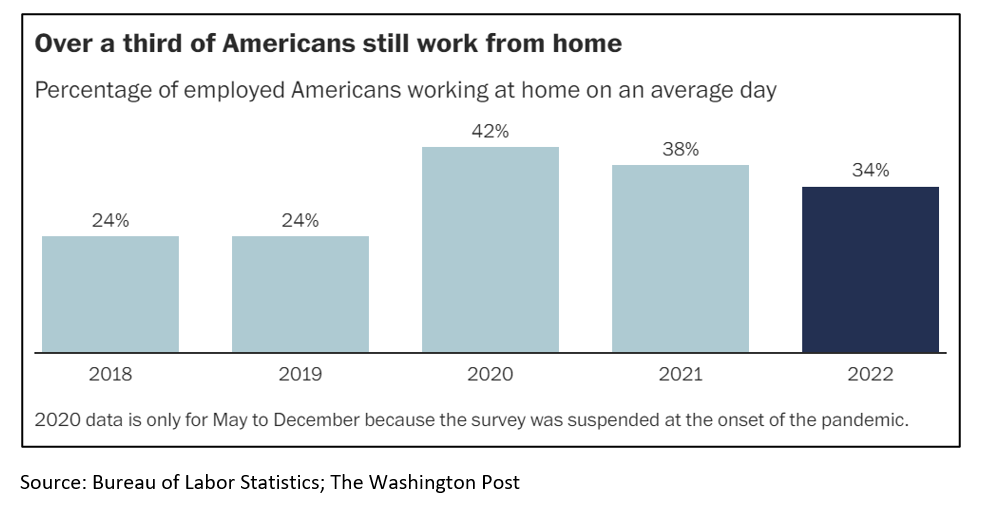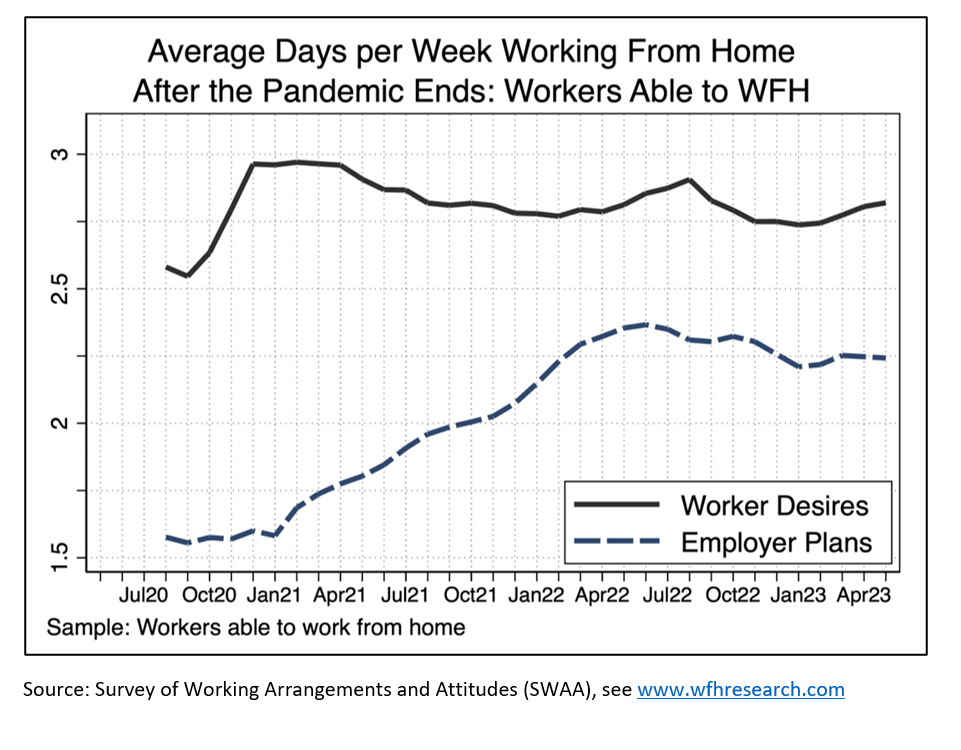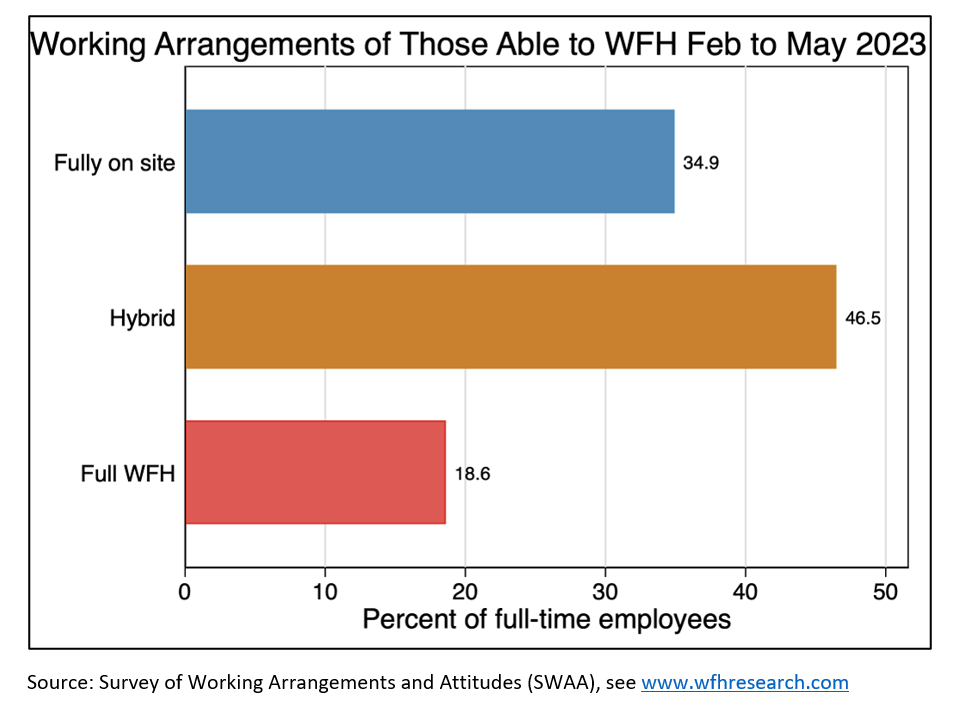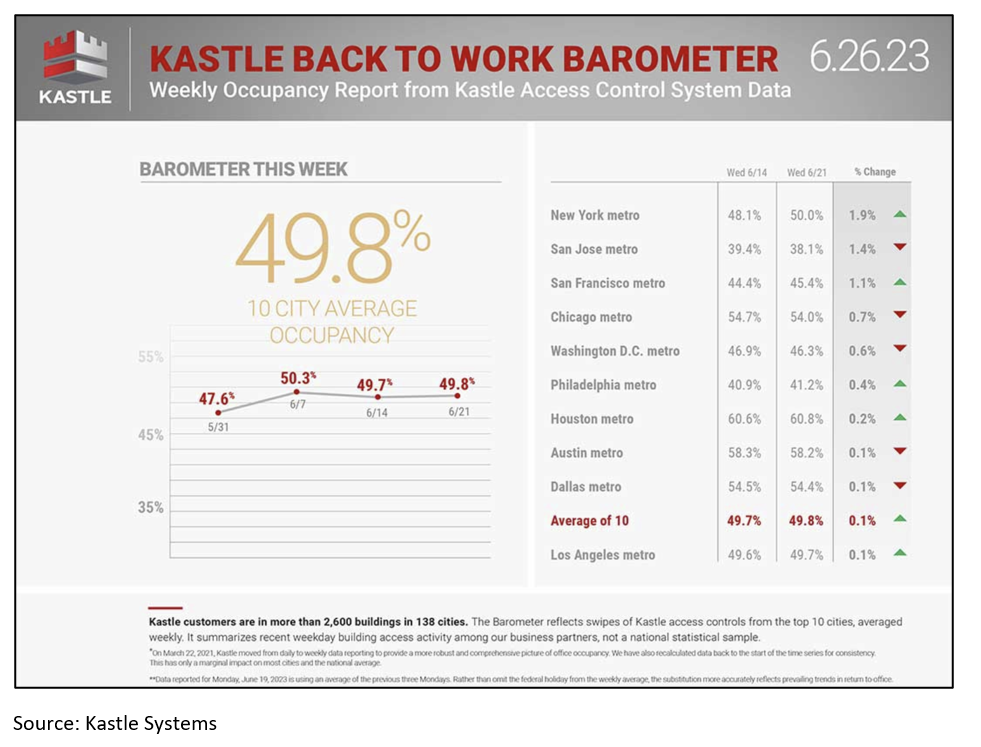Current State of ‘Work From Home’ in the United States
July 10, 2023

With social distancing requirements at the onset of the Covid-19 pandemic, “work from home” became a part of the general vocabulary. More than three years have passed since then, and “work from home” has evolved and continues to affect the current state of everyday life. Learn about the latest data on remote work and some of its effects on real estate markets.
Many employees prefer to work from home.
Based on LinkedIn’s Workforce Insights report, nationally, only 11% of open jobs on LinkedIn offer remote work, but they attract close to 50% of total job applications, as of May 2023. This speaks to the popularity and attractiveness of remote work opportunities. Many companies such as Reddit, Airbnb, Yelp, Spotify, Instacart, and Pinterest have made working from home a permanent option for employees. This has caused an influx of job applications at these companies. Yelp, for example, has seen a 200% increase in the number of applicants for its general and administrative job postings since the company went fully remote in 2022, compared to 2019. The female workforce has seen a particularly pronounced shift towards at-home work. According to the Bureau of Labor Statistics’ American Time Use Survey (ATUS), 26.2% of women worked from home in 2019, which increased to 49.3% in 2020 and dipped to 41% in 2022. All this points to the trend that employees place a premium on flexibility, location independence, and better work-life balance that is made possible by remote work.

Many employers are pushing for a return to the office.
Several companies, such as Tesla, Google, Amazon, Disney, and Starbucks, have implemented and strengthened return-to-office mandates. Many U.S. corporate leaders argue that the prevalence of remote and hybrid setups has run its course and having employees work from the office is best for business. Many firms cite productivity concerns as a cause for their hesitation to offer remote work opportunities. The U.S. Bureau of Labor Statistics reports that in August and September 2022, an estimated 27.5% of private companies allowed their employees to work from home some or all the time, down from 40% a year before. Data from the Survey on Working Arrangements and Attitudes (SWAA) suggests that there continues to be a gap between how often employees want to work from home and employers’ plans for the extent of work from home.

Hybrid appears to be the happy middle.
While it’s yet to be decided whether it will be the employee preferences or employer inclinations that will eventually triumph, it is safe to say that hybrid work options provide the best middle ground for now. Hybrid work arrangements create room for flexibility while allowing for in-person collaboration as and when necessary, based on people’s specific roles within a company. Such a setup is seen to ensure worker engagement and retention as well as a sense of company culture. Recent data from the Survey of Working Arrangements and Attitudes (SWAA) shows that for employees that can work from home, the most common practice is a hybrid arrangement.

Overall consequences continue to take shape.
Sunbelt states saw an influx of people who were looking for less-expensive areas away from densely populated city centers while being able to work for their employers remotely. A report from the Joint Center for Housing Studies at Harvard University suggests that as remote workers are no longer tied to their offices, there has been an increase in housing demand in lower-cost areas. Moreover, many individuals, especially women and caregivers, were able to find a healthy balance between focusing on their personal and professional priorities. Commercial real estate has seen a significant change in demand as return to work following the pandemic has been slow. According to Kastle Systems, a security and data company that tracks office occupancy, offices in the top 10 U.S. metro areas are only at half their occupancy capacity. So, while the fate of “work from home” is yet to be determined, there is no denying the significant effects of the remote work era on everything from commercial real estate, to work culture.

For more information on housing, demographic and economic trends in Virginia, be sure to check out Virginia REALTORS® other Economic Insights blogs and our Data page.
You might also like…
Midway Through 2024, Virginia Home Sales Activity Slightly Outpacing Last Year
By Robin Spensieri - July 24, 2024
According to the June 2024 Virginia Home Sales Report released by Virginia REALTORS®, there were 10,018 homes sold across the commonwealth last month. This is 974 fewer sales… Read More
Three Multifamily Market Trends from the Second Quarter of 2024
By Sejal Naik - July 16, 2024
Each quarter, through its Multifamily Market report, the research team at Virginia REALTORS® analyzes the trends and changes in the multifamily market. Here, we share the key highlights… Read More
Takeaways From the JCHS 2024 State of the Nation’s Housing
By Dominique Fair - July 15, 2024
The Joint Center for Housing Studies from Harvard University released this year’s State of the Nation’s Housing report highlighting the impact today’s market is having on both homeowners… Read More